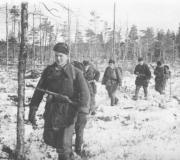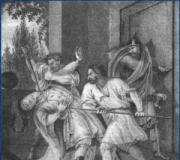Monument of Glory in Novosibirsk. Monument of Glory in Novosibirsk Samples of military equipment
Source: Monuments of history and culture of the Kuibyshev region. Kuibyshev book publishing house, 1979.
This majestic monument is a complete composition. A 40-meter pedestal stele is installed on a massive granite pedestal. It is crowned with a sculpture of a worker (the height of the sculpture is 12 meters). On his outstretched arms, the worker holds inclined planes, symbolizing wings. The figure, elevated above the steep slope of the Sokoli Mountains, faces the Volga. From the embankment, from Volzhsky Prospekt, a diverging staircase leads to the monument.
This beautiful monument is a hymn to the Soviet man - a fighter and worker. The monument was laid on the eve of the 50th anniversary of the Great October Revolution. Opened on November 5, 1971.
Postcards and photographs from the website of Georgy Bichurov http://www.bichurov.ru/
The pedestal stela, the worker sculpture, and the wing planes are made of stainless steel.
A memorial ensemble was built near the monument. Its ideological and thematic center is the mournful face of the Motherland carved from granite. It is surrounded by bowed banners, also carved from granite. The Eternal Flame burns in front of the sculptural bas-relief. The flame bursts out of the bowl, which is enclosed in a bronze star. This fire was lit from a torch brought here from Revolution Square, from the monument to V.I. Lenin.
May 9, 1975
June 1975
Mid 1970s
The memorial reflects the military heroism of our fellow countrymen in the struggle for the victory of the socialist revolution, the sacred national memory of those who did not return from the battlefields during the Civil and Great Patriotic Wars.
December 1978
On the way to the memorial ensemble from Galaktionovskaya Street, which crosses the square, there are five granite pylons in a row. On each of the upper parts there are inscriptions on both sides in stainless steel letters.
On the first pylon it is written: “Here (in Samara) Lenin began his journey into the revolution”; “The workers’ and peasants’ revolution, the need for which the Bolsheviks were always talking about, has come true! V.I. Lenin.”
On the second: “During the civil war in the Volga region, the fate of the revolution was twice decided”; "Power to the Soviets! Peace to the peoples! Land to the peasants!"
On the third: “The courage of the heroes of the first five-year plans calls us to exploits in labor”; “Socialism was built through the heroic labor of the people.”
On the fourth: “Here the rear was the front”; “Our cause is just, we won!”
On the fifth are bas-reliefs of two Orders of Lenin, which were awarded to the Kuibyshev region and the texts: “Reward of the Motherland for the labor valor of the Kuibyshevites”; "The victory of communism is inevitable, victory will be ours. V.I. Lenin."
The monumental composition was made according to the design of TsNIIproektstalkonstruktsiya (chief engineer of the project - S.K. Kanevsky). Many industrial organizations of the city of Kuibyshev took part in the creation of the memorial ensemble. The sculptural part of the memorial was carried out at the Mytishchi artistic casting plant and at the experimental plant of the Moscow Art Fund.
The design of the new square was led by Kuibyshevgrazhdanproekt engineer P.V. Nazarov.
The area is more than 2 thousand square meters. It is enclosed by modern buildings, covered with concrete slabs, landscaped, and has fountains of an original design. At night, the area is illuminated with spotlights and lamps.
Set of postcards from 1985-1986
This is one of the favorite vacation spots for Kuibyshev residents and city guests. From the foot of the monument a majestic panorama of the Volga and the embankment, the Trans-Volga distances opens up, from here on the right are the spurs of the Zhigulevsky Mountains, the Zhigulevsky Gate. Celebrations and celebrations are held on the square.
The Great Patriotic War of 1941 - 1945 will forever remain in people's memory as an example of unparalleled courage and mass heroism of the Soviet people, who defeated the enemy and ensured a peaceful sky above their heads for future generations at the cost of their lives.
In memory of the heroes of that Great War, monuments and memorials were erected in almost every city of the Soviet Union, testifying to the deep respect of the people for the heroic defenders of their Fatherland. Even in the most remote corners of the country there are always monuments erected in honor of the heroes of the terrible and bloody war.
In the city of Novosibirsk, a Monument of Glory was also erected, dedicated to the heroic Siberians - defenders of the Motherland who participated in the Great Patriotic War. This memorial complex was installed in the Leninsky district of the city. Its grand opening took place in the fall of 1967. Today, this magnificent complex is part of the cultural heritage of Russia.

The history of the creation of the memorial complex.
The project for the monumental monument to Glory was created and brought to life by a talented artist - monumentalist from Novosibirsk Alexander Chernobrovtsev. In addition to him, other famous sculptors also participated in the development of the monument project.
The Monument of Glory is a memorial complex, which is located on a territory with a total area of two hectares. The monumental complex includes several separate monuments, each of which in itself is an outstanding monument of sculpture and.

Monuments and structures as part of the Glory complex.
The following monuments can be distinguished as part of the memorial complex:
- Monument to a Grieving Woman.

- Symbol of the Eternal Flame, which was lit in memory of the fallen heroes of the Great Patriotic War, who gave their lives for the peace and tranquility of their native land. A similar symbolic fire burns at many memorial monuments throughout the country.

- Five huge pylons, each of which reaches a height of 10 meters. They contain relief images of various stages of military operations, up to the victory over the fascist invaders.

- Urns with earth, brought from the places where the most fierce and bloody battles took place. This land is sacred because the blood of the fallen defenders of our Motherland remains on it.
The enormous cultural and historical value of the Glory Monument in Novosibirsk was documented in 1974, 7 years after the construction of the monuments that form the basis of the composition of the memorial complex.
After the creation of the Glory memorial complex itself, a picturesque park was laid out around it, in the center of which there is an Alley of Glory, decorated with hundreds of specially planted fir trees, which are dedicated to the Heroes of the Soviet Union from Novosibirsk.
At the end of the 20th century, namely in 1999, a new monument was erected on the territory of the Glory memorial complex, which its authors dedicated to labor veterans who worked at defense enterprises in Siberia during the war of 1941 - 1945.
A little later, at the beginning of the 21st century, the memorial complex was replenished with another very beautiful structure. So, in the early 2000s, the Chapel of St. George the Victorious was built, the construction of which was dedicated to the heroes - the Siberians.

Features of the architecture of the Glory Monument.
The architecture of the Glory memorial complex is diverse, but at the same time it is maintained in the same stylistic manner. All monumental buildings, monuments and sculptures bear the imprint of strict solemnity, which at the same time is devoid of any pomp and deliberate luxury. For the construction of monuments and sculptures, both the simplest types of materials were used - natural stone and, as well as expensive facing slabs made of natural granite.

Samples of military equipment.
On the territory of the memorial complex - the Monument of Glory in Novosibirsk, several types of military equipment from the times of the USSR are also presented, which to a large extent helped our soldiers defeat the enemy.
Among the examples of military equipment of the Soviet era are the following:
- M - 30 is a 1938 model howitzer with a caliber of 122 mm. This type of weapon was produced in the Soviet Union from 1938 to 1955. During the Great Patriotic War, the use of howitzers was widespread; they were often installed on self-propelled artillery mounts.

- YAK - 9 is a fighter-bomber class aircraft, which was mass-produced in the USSR from 1942 to 1948, and was actively used in combat aviation during the Great Patriotic War.

- ZIS - 2 is an anti-tank gun with a caliber of 57 mm. In the Soviet Union, the cannon was produced since 1941, and was characterized by a high power shot, capable of penetrating the strongest armor. At that time, there were no analogues of such an anti-tank gun in the whole world, and it was the ZIS-2 that was a worthy opponent for the German Tiger tanks equipped with heavy armor.

- ISU - 152 is a self-propelled heavy artillery unit that was actively used during the war. The main armament of the vehicle had a caliber of 152 mm. The production of artillery self-propelled guns began in 1943, and subsequently vehicles of this type were in service with the Soviet army for a long time.

- BM - 13 is a legendary field rocket artillery system, which people lovingly called “Katyusha”. Such installations were used during the Great Patriotic War. The use of Katyushas often predetermined the outcome of battles.

- T - 34 - 85 is a model of the legendary Soviet T-34 tank, on which an 85 mm caliber gun was installed. This tank was the latest modification of the T-34 and was put into service in 1944. In this combat vehicle, many functional indicators were improved and combat effectiveness was increased.

This term has other meanings, see Monument of Glory. The Monument of Glory is a memorial in memory of the victors over Nazism in the Great Patriotic War, located in Lviv (Ukraine). Contents 1 General information 2 See also... Wikipedia
This article needs to be completely rewritten. There may be explanations on the talk page. This term has other meanings, see Monument C... Wikipedia
This term has other meanings, see Monument of Glory. Monument Monument of Glory Monument of Glory ... Wikipedia
The Monument of Glory is a memorial in memory of the victors over Nazism in the Great Patriotic War, located in Lviv (Ukraine). Contents 1 General information 2 See also 3 Literature used ... Wikipedia
The Monument of Glory is a memorial in memory of the victors over Nazism in the Great Patriotic War, located in Lviv (Ukraine). Contents 1 General information 2 See also 3 Literature used ... Wikipedia
- λ59.843056, 30.321944 ... Wikipedia
monument- Question Which is correct: “a monument to whom” or “to whom”? The control of the word monument depends on the meaning of the word. A monument to whom is a sculptural structure of significant size in honor of some outstanding person: a monument to a great writer; ... ... Dictionary of difficulties of the Russian language
The opening of the memorial took place on May 8, 1967. The Eternal Flame, burning near the walls of the Kremlin, was lit from the Eternal Flame on the Field of Mars in St. Petersburg (then Leningrad). The torch was delivered by relay, and along the entire route there was a living corridor - people considered it their duty to pay tribute to the memory of all those who died in that terrible war. In Moscow, near Manezhnaya Square, the torch was accepted by the Hero of the Soviet Union, the famous pilot Alexei Maresyev, and the Eternal Flame was lit by the General Secretary of the CPSU Central Committee, Leonid Brezhnev.
The memorial was created according to the design of the sculptor N. Tomsky and architects D. Burdin, V. Klimov, Yu. Rabaev, M. Shvekhman. He turned out to be strict and noble. It is decorated with crimson Shoksha quartzite, red polished porphyry granite and dark gray labradorite. The sculptural composition is based on three elements made of cast bronze: a soldier’s helmet, a laurel branch and a flowing banner, which lie on the tombstone. Next to the Eternal Flame, blazing in the center of the five-pointed star, there is the inscription: “Your name is unknown, your feat is immortal.”
To the left of the main part of the composition there is a wall with the inscription “1941-1945. To those who fell for the Motherland”, on the right is an alley with twelve blocks-symbols of hero cities. Each block is topped with a chased Gold Star medal and contains a capsule with soil brought, respectively, from Leningrad, Kiev, Minsk, Stalingrad, Sevastopol, Odessa, Kerch, Novorossiysk, Murmansk, Tula, Smolensk, Brest Fortress. There is also a stele here that lists the hero cities to which this honorary title was awarded later. It was opened on May 8, 2010, on the eve of the 65th anniversary of the Great Victory, along with the updated memorial.
Restoration of the monument
Comprehensive restoration and modernization of the monument was carried out in accordance with the decree of the President of the Russian Federation “On the National Memorial of Military Glory” adopted in 2009. Then the Eternal Flame was temporarily moved to Poklonnaya Hill, and then, upon completion of the work, on February 23, 2010 it was returned to its original place.
Since December 1997, post No. 1 has been installed at the Tomb of the Unknown Soldier. The guard is carried out by soldiers of the Presidential Regiment, who change every hour.




